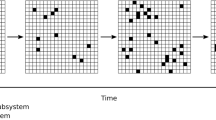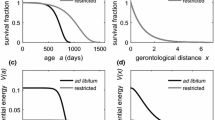Abstract
It is well documented, in the biological literature, that many species throughout the animal kingdom exhibit Gompertzian or Weibull-like population level total survival distributions. Many researchers have long assumed, believed, or otherwise postulated that an individual organism, in such a population, survived according to an exponential survival distribution. Using well-known results from reliability theory, it is shown that if every individual in the population has an exponentially distributed lifespan, then a Gompertzian or Weibull-like group/population level dynamics (or any other dynamics with a strictly increasing mortality rate for some interval) is not possible. This implies that, for species with a population level Gompertzian or Weibull (with the mortality rate strictly increasing) survival curve, some or all of the individual organisms must have non-exponentially distributed lifespans.
Similar content being viewed by others
Literature
Comfort, A. 1979.The Biology of Senescence. Amsterdam: Elsevier/North-Holland.
Barlow, R. E., A. W. Marshall and F. Proschan. 1963. “Properties of Probability Distributions with Monotone Hazard Rate.”Ann. math. Statist. 34, 375–389.
Barlow, R. E. and F. Proschan. 1981.Statistical Theory of Reliability and Life Testing: Probability Models. Silver Spring. MD.
Hollander, M. and F. Proschan. 1984. “Nonparametric Concepts and Methods in Reliability.” InHandbook of Statistics, Nonparametric Methods, P. R. Krishnaioh and P. K. Sen (Eds),4, 613–655. Amsterdam. Elsevier/North Holland.
Jacobson, P. H. 1964. “Cohort Survival for Generations since 1840.”Milbank Memorial Fund Quarterly 42, 36–51.
Jewell, N. 1982. “Mixtures of Exponential Distributions.”Ann. Statist. 10, 479–484.
Proschan, F. 1963. “Theoretical Explanation of Observed Decreasing Failure Rate.”Technometrics 5, 375–383.
Witten, M. 1983. “A Diffusion Process Approach to Stochastic One-compartmental Models.”Bull. math. Biol.,45, 425–430.
— 1984. “A Return to Time, Cells, Systems and Aging—II. Relational and Reliability Theoretic Approaches to the Study of Senescence in Living Systems.”Mech. Aging Dev. 27, 323–340.
— 1985. “A Return to Time, Cells, Systems and Aging—III. Gompertzian Models of Biological Aging and Some Possible Roles for Critical Elements.”Mech. Aging. Dev. 32, 141–177.
— 1986. “A Return to Time, Cells, Systems and Aging—IV. Further Thoughts on Gompertzian Survival Dynamics—The Neonatal Years.”Mech. Aging Dev. 33, 177–190.
Yu, B. P., E. J. Masoro, I. Murata, H. A. Bertrand and F. T. Lynd. 1982. “Lifespan Study of SPF Fischer 344 Male Rats FedAd Libitum or Restricted Diets: Longevity, Growth, Lean Body Mass, and Disease.”J. Georont. 37, 130–141.
Author information
Authors and Affiliations
Rights and permissions
About this article
Cite this article
Guess, F., Witten, M. On the incompatibility of gompertz or weibull survival dynamics with exponentially distributed individual lifespans. Bltn Mathcal Biology 50, 187–192 (1988). https://doi.org/10.1007/BF02459951
Received:
Revised:
Issue Date:
DOI: https://doi.org/10.1007/BF02459951




